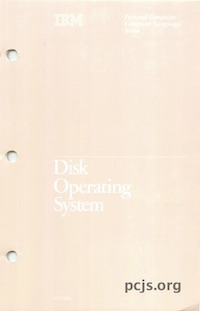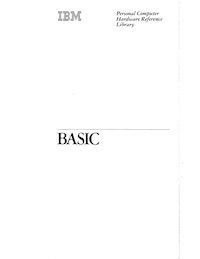PCjs Machines
Home of the original IBM PC emulator for browsers.

IBM PC DOS 1.10
PC DOS 1.10 was released in May 1982 on one single-sided (160Kb) diskette.
Directory Listing, Documentation, and Feature Summary are provided below. Also see IBM’s “Read This First” from the PC DOS 1.10 Manual for important information about changes from PC DOS 1.00.
You can also dig into the PC DOS 1.10 Boot Sector using the PCjs Debugger.
[PCjs Machine "ibm5150-pcdos110"]
Waiting for machine "ibm5150-pcdos110" to load....
Directory of PC DOS 1.10
Volume in drive A has no label
Directory of A:\
IBMBIO COM* 1920 5-07-82 12:00p
IBMDOS COM* 6400 5-07-82 12:00p
COMMAND COM 4959 5-07-82 12:00p
FORMAT COM 3816 5-07-82 12:00p
CHKDSK COM 1720 5-07-82 12:00p
SYS COM 605 5-07-82 12:00p
DISKCOPY COM 2008 5-07-82 12:00p
DISKCOMP COM 1640 5-07-82 12:00p
COMP COM 1649 5-07-82 12:00p
EXE2BIN EXE 1280 5-07-82 12:00p
MODE COM 2509 5-07-82 12:00p
EDLIN COM 2392 5-07-82 12:00p
DEBUG COM 5999 5-07-82 12:00p
LINK EXE 41856 5-07-82 12:00p
BASIC COM 11392 5-07-82 12:00p
BASICA COM 16768 5-07-82 12:00p
ART BAS 1920 5-07-82 12:00p
SAMPLES BAS 2432 5-07-82 12:00p
MORTGAGE BAS 6272 5-07-82 12:00p
COLORBAR BAS 1536 5-07-82 12:00p
CALENDAR BAS 3840 5-07-82 12:00p
MUSIC BAS 8704 5-07-82 12:00p
DONKEY BAS 3584 5-07-82 12:00p
CIRCLE BAS 1664 5-07-82 12:00p
PIECHART BAS 2304 5-07-82 12:00p
SPACE BAS 1920 5-07-82 12:00p
BALL BAS 2048 5-07-82 12:00p
COMM BAS 4352 5-07-82 12:00p
28 file(s) 147489 bytes
7168 bytes free
CHKDSK reports:
160256 bytes total disk space
8704 bytes in 2 hidden files
144384 bytes in 26 user files
7168 bytes available on disk
In case you’re wondering why 1920 + 6400 does not equal the “8704 bytes in 2 hidden files” reported by CHKDSK, that’s because all CHKDSK byte totals are cluster-granular. On a 160Kb diskette, 1 cluster equals 1 sector or 512 bytes.
CHKDSK considers the size of IBMBIO.COM to be 2048 bytes (1920 rounded up to the nearest 512 multiple), and the size of IBMDOS.COM is 6656, so the total number of bytes consumed by those two files is 8704.
Documents
Feature Summary
New features:
- Double-sided 320KB floppy disk support
- Directory entries include the time last written in addition to the date
- INT 24h vector saved in PSP
- COPY supports concatenation of multiple files
New internal commands:
- DATE
- DEL
- REN
- TIME
New external commands:
- EXE2BIN
New functions:
- INT 21h functions 1Ch, 1Fh, 2Eh
Read This First
From the PC DOS 1.10 Manual:
Welcome to DOS Version 1.10 for your IBM Personal Computer. Whether you are using DOS for the first time or upgrading to this enhanced version, this brief discussion contains some information about Version 1.10 that may be of importance to you. For more specific information about the topics in this document, refer to the appropriate sections of the DOS manual.
DOS Version 1.10 contains incremental functional enhancements, performance improvements and support for the IBM 320K 5 1/4” Diskette Drive. Although Version 1.10 is functionally compatible with Version 1.00 there are some differences that you should be aware of and, if necessary, take the appropriate course of action for your particular situation.
Increased Memory Requirements
First, DOS Version 1.10 is about 250 bytes larger than Version 1.00 and BASIC or BASICA Versions 1.10 are about 200 bytes larger than their Version 1.00 counterparts. In general, this should not affect any of the applications that you have written and already run with Version 1.00. Should you encounter the rare case of having one of your applications “not fit” with Version 1.10, it may be necessary to “trim” your program to run with Version 1.10. Although we’ve made every effort to keep things from growing, some growth was unavoidable.
Our one application affected by the growth in Version 1.10 is the IBM Asynchronous Support program. For those of you who will be using this program under Version 1.10, it will be necessary to change line 2 of the AUTOEXEC.BAT file on the Communications program diskette (that’s the line that invokes BASIC and subsequently the program TERMINAL) to the following:
BASIC TERMINAL/C:0
You can use either DOS EDLIN or COPY to make this change.
DOS Packaging Changes
Another DOS Version 1.10 change is the packaging of some DOS functions. For example, in Version 1.00, TIME and DATE are external commands (individual COM files). In Version 1.10 they are part of DOS itself (internal). Thus, it is not necessary to copy these functions to any of your DOS-based applications in Version 1.10. If you have any batch programs that copy these functions to your applications, they don’t need to be changed; but don’t be alarmed if you get the message:
0 File(s) Copied
in response to a Version 1.10 DOS COPY command for any such request. We mention this because some of our applications (like Dow Jones Reporter) put these commands on their program diskette.
Serially Attached Printer Support
One significant Version 1.10 change is to the DOS MODE command for the dynamic reconfiguration of DOS to support serially attached printers. This means it is no longer necessary to change any applications to do this. With the MODE command you can reassign the DOS default printer (LPT1:) to the appropriate asynchronous communications (RS232) adapter (either COM1: or COM2:) for your printer. Also, with the MODE command you can specify the characteristics of your serially attached printer (parity, baud rate, etc.).
320K Drive Support
The last and most significant areas of change are for 320K Diskette Drive support. Although it depends upon your specific system configuration, there are several functional changes to DOS Version 1.10 that can affect your environment or applications if you have 320K drives on your system. The system configuration that must be considered is one where you have “mixed” diskette drives on your system (ie. Drive A is 160K and Drive B is 320K or the reverse). Under DOS Version 1.10 diskettes formatted for dual-sided use on a 320K drive cannot be processed on a 160K drive. However, those formatted on a 160K drive can be processed on a 320K drive.
On most systems with “mixed” drives this probably will not be a problem as you can still backup your diskettes and data by using DOS DISKCOPY and alternating the source and target diskettes on the same drive.
Where this can present a problem for systems with “mixed” drives is with applications that can only make one backup copy of the application program diskette.
WARNING
With DOS Version 1.10 and on a “mixed” drive system it is possible to make a backup copy of an application that will not run on the system that it was made on. This potential usually exists on systems where Drive A is 160K, Drive B is 320K and the process to create the backup diskette uses the DOS FORMAT command first to format the backup diskette and then the DOS COPY command to copy the programs onto the backup diskette. Should you have this situation and it can exist, then use the DOS TYPE command to display any batch file that may be used to create a backup copy. If the display shows a line like the one that follows:
FORMAT B:/S
then use the DOS EDLIN command and change that line to the following:
FORMAT B:/S/1
In the case of the IBM Dow Jones Reporter where you are following the instructions in the book and you are told to enter:
FORMAT A:/S
to avoid any potential problems type
FORMAT A:/S/1
This will insure your backup diskette is formatted the same as the Reporter diskette.
We bring this to your attention because the DOS FORMAT command always formats the diskette to the capacity (hardware specification – 160K or 320K) of the target drive, unless you override this default by specifying /1 on the FORMAT command to format a diskette for 160K on a 320K drive.
Another IBM application that is designed for 160K drives is Time Manager. If you are formatting a Time Manager Data Diskette you must use
FORMAT /1
or the data diskette will not be usable.
Unlike FORMAT, the Version 1.10 DISKCOPY command always formats the target diskette to the same format as the source diskette. Be aware, however, you cannot use DISKCOPY to copy a 320K-formatted diskette onto a 160K diskette drive.
In Closing
A final word about DOS Version 1.10 – we’ve just brushed the surface of the many enhancements. If you are a Version 1.00 user, take the time to read the DOS manual to gain a more detailed understanding of the new and enhanced functions. If you are not a former user, then read the book anyway; it will help you get started more quickly.

